| MAPPING
PROJECTS
| IRWMP
- Integrated Regional Water Management Plan |
|
|
|
| 
|
 |
 |
|
| Los Angeles
County, CA
In order to deal with long term
water supply and water quality issues in the Greater Los Angeles
County Region - an area representing approximately nine million
people and over 2,200 square miles - local agencies, organizations,
cities, and county government are working together to develop an
Integrated Regional Water Management Plan (IRWMP) for the Region.
Duvivier Architects worked
as a consultants to the prime, Brown and Caldwell, to produce all
the maps for the final document and the workshops. Duvivier Architects
also produced the Open Space requirements. |
 |

slide show
(click picture) |
|

|
top
| Ballona
Watershed Green Map |
|
|
|
| 
|
 |
 |
|
|
Santa Monica, CA
2000
The Ballona
Watershed Green Map displays ecological and cultural resources found
throughout the Ballona Watershed. This includes important waterways,
wildlife migration routes, wetlands, public lands, alternative transportation
corridors, environmental organizations and green businesses.
WHAT IS A WATERSHED?
and why make a watershed map?
A watershed is an area of land that
drains all of the rain that falls within it to a common point. This
map identifies environmental features and resources in the Ballona
Watershed, which is part of the larger Santa Monica Bay Watershed.
The Ballona Watershed drains through Ballona Creek to Santa Monica
Bay.
Studying a watershed gives us a
unique look at the relationships between water, earth, and people.
Watersheds provide habitat for plants and animals and provide important
environmental benefits such as water filtration and storage. The
hydrologic cycle (precipitation, percolation and evaporation) shapes
the earth's topography which affects the plant and animal species
found in the area. Humans rely on watersheds by making use of water
habitat. However, by channeling streams and paving over the earth,
we have drastically altered the original percolation and filtration
zones of the watershed. It is our hope that the reader will contemplate
these changes, and also dream of how we might restore some of the
watershed while continuing to enjoy living an urban life in Southern
California.
The Ballona Watershed Green Map
shows the entire watershed of La Ballona Creek including the communities
of Santa Monica, Culver City, Beverly Hills, Inglewood, West Hollywood,
Venice, West Los Angeles, and Los Angeles. It also shows the natural
features that run throughout the watershed. These features include:
- Watershed definition and boundaries.
- Existing, as well as former creeks
and streams.
- Water sources inventory (the source
of local water).
- Fresh water sources such as reservoirs
and lakes.
- Storm water pollution sources (which
affect water quality in the watershed and Santa Monica Bay)
- Bird migration corridors and species.
- Native plant, butterfly and animal
information.
- Endangered species.
- State parks.
- Current greening and habitat restoration
projects and opportunity sites.
- Environmental schools (schools
that have agreed to unpave a large percentage of asphalt and plant
trees). |
 |
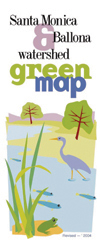
download
map (1.6MB)
|
|
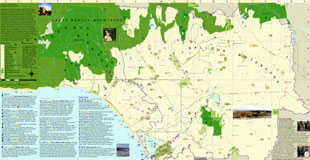
Click
on the map to view full size
|
|
Santa
Monica Green Map
|
|
|
|
| 
|
 |
 |
|
| Santa
Monica, CA
2000
The
Santa Monica Green Map shows green businesses as well as ecological
features. This map has been created to help residents and visitors
to the region become aware of the abundance of resources that contribute
to the making of a more sustainable community. The map will allow
users to visualize the breadth and diversity of the local environmental
resources and opportunities. On this map one finds features such
as:
-
Sustainable Quality Award Winners (businesses which received awards
from the City of Santa Monica).
- Stores
that sell green building products and green designers.
-
Environmental organizations such as schools which have "learning
gardens", offer organic salad bars or compost on-site.
- Vegetarian
restaurants and natural food stores.
- Location
of car oil recycling centers.
- Types
and locations of all storm water percolation systems including statistics
on the volume of water mitigated.
- Sample
catch basin inserts installed to filter out urban run-off before
it enters the Bay.
- Location
and facts about SMURRF — Santa Monica Urban Runoff Recycling Facility,
solar energy and green power sites.
- Bike
and blade shops, bus routes, bike paths and walking routes.
- Street
trees 60' and up with trunk diameters of 30" and up and trees planted
since 1997 by City of Santa Monica as part of their commitment to
reducing global warming and improving air quality in LA.
- Storm
water percolation sites.
- Green
Power Customers.
Development
of the Green Map was funded by the City of Santa Monica's Environmental
Programs Division (EPD) for use as an environmental education tool
for residents, visitors, students and other community stakeholders.
With the Green Map, the EPD hopes to stimulate discussion and ultimately
inspire and promote a wide variety of sustainable practices such
as reductions in energy use, water use and waste generation, use
of environmentally friendly transportation options, purchase of
environmentally friendly goods and services, and increased consumption
of regional and organic foods. In addition, the Map will be used
by Santa Monica teachers to help educate students about a variety
of ecological issues in the watershed including water quality and
conservation, the habitat needs of animals and plants, the impact
of non-native species, the consequences of sprawl, the impact of
consumer choices on the natural and built environment, and the interconnectedness
of our actions and policy decisions.
Development
and data collection for the Green Map involved input from a variety
of stakeholders throughout the watershed. The map makers worked
with the Santa Monica High School Biology Department and Wildlife
Club, the West LA chapter of the Audubon Society, the Santa Monica
College Geo-Club, and many remarkable naturalists and business leaders.
Not only were the encounters educational and fun (bird watching
by sea kayak, wild edible plant gathering), they have spurred on
new projects (including a new native plant garden at Santa Monica
College) and brought different groups together who may not normally
meet. |
 |
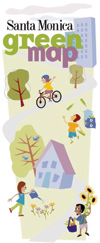
download map (0.6MB) |
|
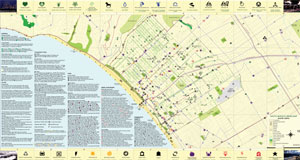
Click
on the map to view full size |
top
| Kids'
Santa Monica Pier Green Map
|
|
|
|
| 
|
 |
 |
|
| Santa
Monica, CA
2000
My Watershed, the Ocean and Me
- Kid’s Green Map includes downtown Santa Monica, the Santa
Monica Pier and adjacent Santa Monica Bay. The purpose of the map
is to show the marine aquatic life found under and around the pier
and adjacent beaches. It also illustrates the impact of pollution
from activities on the pier and downtown.
The habitat communities found under
or near the pier include the:
- beach.
- sandy sea bottom.
- breakwater.
- pier pilings.
- open ocean.
- Santa Monica Bay Watersheds.
Information about the creatures
which live in the above habitat communities is located on this map
such as:
- Arthropoda: crabs, lobster;
shrimp.
- Mollusca: mussels, snails, clams and octopus.
- Echinodermata: sea stars, urchins, sea cucumber and sand dollars.
- Cnidaria: sea jellies and anemone.
- Chordata: sharks, rays, bony fish, dolphins, whales, birds and
us.
- Protista: sea plants.
These habitats suffer a number
of problems including water quality impairments, public health issues
and marine life degradation associated with human behavior on land.
This Green Map aims to support long-term water quality protection,
pollution prevention and marine habitat protection and restoration
by addressing a major cause of environmental degradation: lack of
public awareness/concern.
The map focuses attention on a
variety of critical resource issues including understanding ocean
life, coastal water quality and public health, polluted storm-water
runoff and illegal dumping, water conservation, the importance and
biology of watersheds and a sense of belonging to a larger community
with common environmental concerns.
Development of the Green Map was
partially funded by the City of Santa Monica's Environmental Programs
Division (EPD) for use as an environmental education tool for residents,
visitors, students and other community stakeholders. The Map is
also used by Santa Monica teachers to help educate students about
a variety of ecological issues in the watershed including water
quality and conservation, the habitat needs of animals and plants,
the impact of consumer choices on the natural and built environment,
and the interconnectedness of our actions and policy decisions.
Maps are available free of charge
in libraries, bookstores, parks, tourist information offices and
farmers’ markets. |
 |
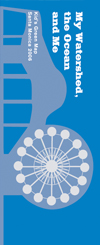
download map (3.6 MB) |
|
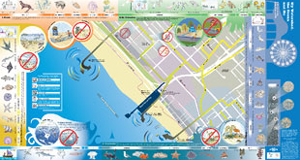
Click on the map to view full size
Critters
(Click
on the images to see the slide show)
|
top
| Malibu
Creek Green Map |
|
|
|
| 
|
 |
 |
|
| Living
Lightly in Our Watershed
Duvivier Architects produced the Malibu Creek Green Map for the
Resource Conservation District of the Santa Monica Mountain's Living
Lightly in Our Watershed, a guide for residents of the Malibu Creek
Watershed and adjoining watersheds including the cities of Malibu,
Agoura Hills, Westlake Village, Calabasas and portions of unincorporated
Los Angeles County such as the communities of Topanga, Malibu Lake
and Monte Nido. This guide is designed to provide local residents
with information to help make watershed protection and preservation
easier by teaching about the natural resources, how to improve their
immediate environment while saving money. |
 |
|
|
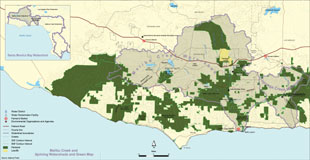
|
top
OTHER
PROJECTS
County of Mariposa GreenMap under development
Mariposa County, CA
Santa Monica GreenMap
2000
City of Santa Monica
Santa Monica, CA
Ballona Watershed GreenMap
2000
City of Santa Monica
Santa Monica, CA
top
projects:
architecture
| urban
|
 |



























